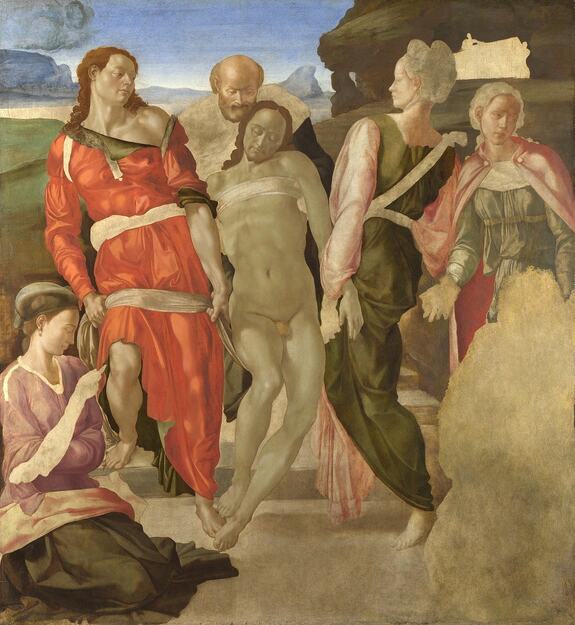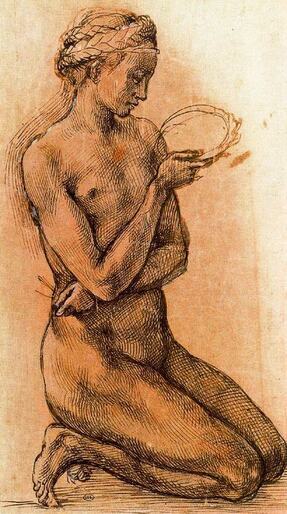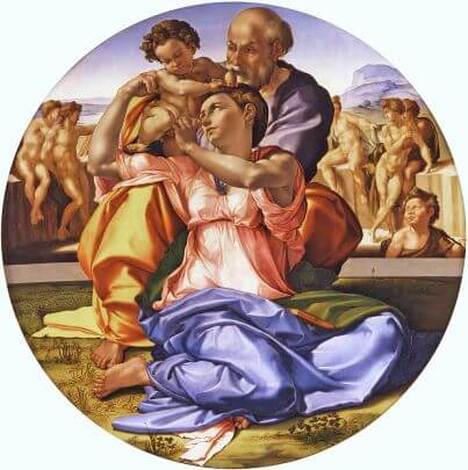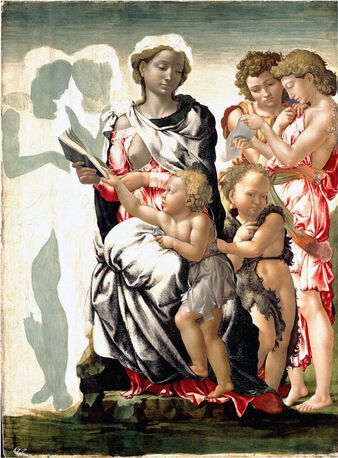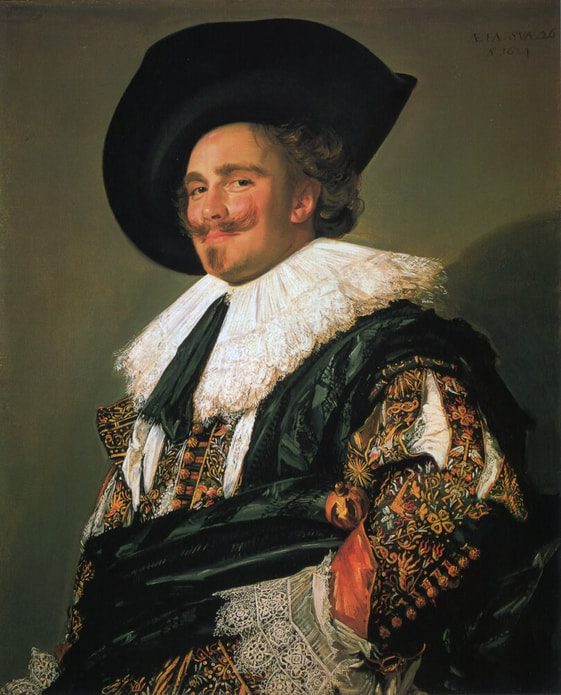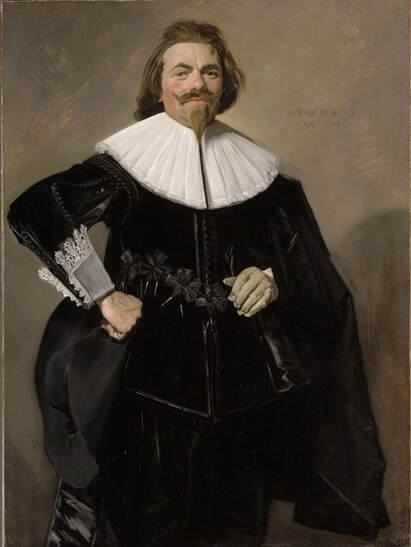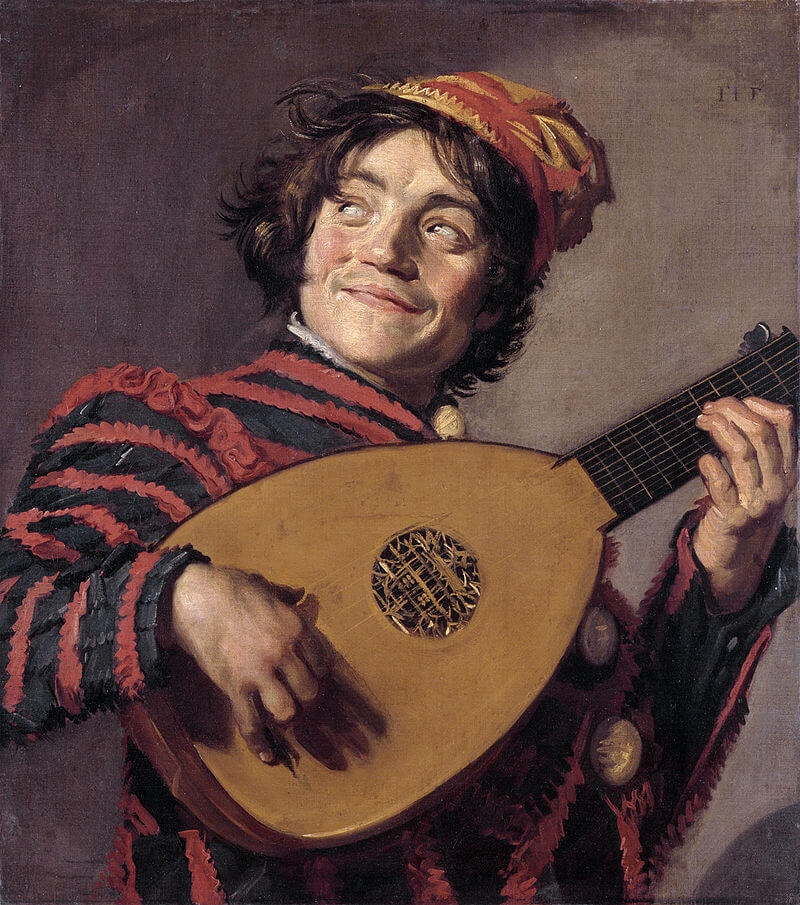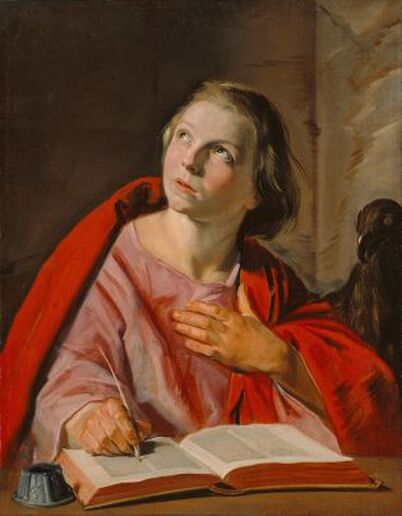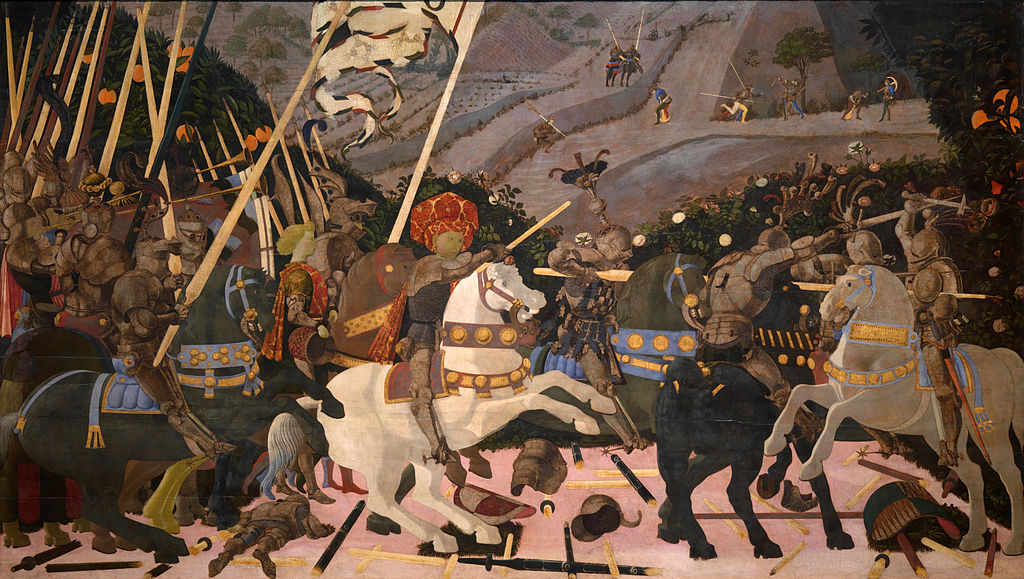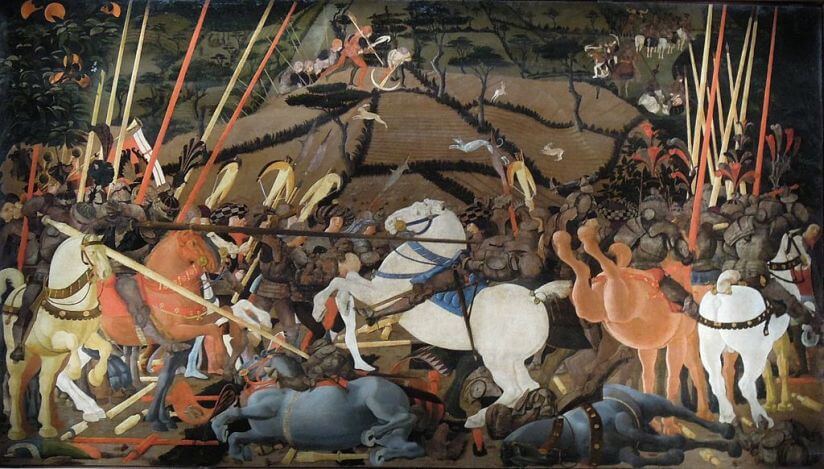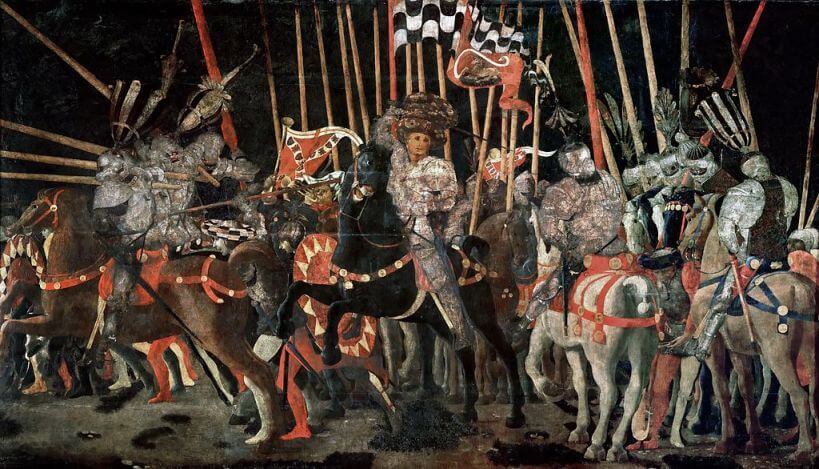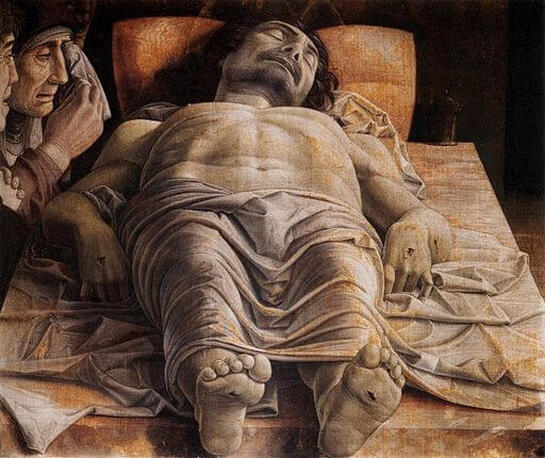|
Where? Room 20 of the National Gallery
When? Probably 1500-1501 Commissioned by? Possibly for the church of Sant'Agostino in Rome
What do you see? This unfinished painting shows how the lifeless body of Jesus is carried up some steps to be put in his tomb. The beautifully-painted body of Jesus has already been washed after the crucifixion as there is no sign of blood on his hands and feet and the crown of thorns has been removed. The tomb was owned by Joseph of Arimathea, who is the bearded man standing behind Jesus. Two broad linen bands support the body of Jesus. The person to the left of Jesus in the magnificent red-orange robe is Saint John, and the person on the right is probably Nicodemus.
Backstory: This painting provides a good look at how Michelangelo worked on a painting. For this painting, he first created a drawing and based on that he painted the different parts and colors one by one. Because this painting is unfinished, there has been quite some uncertainty and debate about this painting over the years.
There are different theories about when he painted this, for who, and whether it is a painting from Michelangelo or whether the painting or parts of it should be attributed to some of his students. But there is also uncertainty about who is who in the painting. For example, it is not completely clear who is Mary Magdalene and who is Mary Salome in the picture, and there is also debate whether the person directly to the right of Jesus is indeed Nicodemus (or maybe a woman instead). What is the entombment? The burial of Jesus is described in the four Gospels and is referred to in the letter of Paul to the Corinthians. The Gospels tell somewhat different stories on the burial of Jesus. In short, Joseph of Arimathea asked for the body of Jesus after the crucifixion to bury it in accordance with the Jewish law which stated that a body could not be left exposed during the night. According to the Gospel of John, he got help from Nicodemus. Mary Magdalene and the Virgin Mary were also present at the burial. The body of Jesus was washed, wrapped in linen, and spices were put on the linen. After that, the body of Jesus was put in a tomb cut out of rock and a big stone was rolled in front of the entrance. Why the entombment? While it is not entirely clear who commissioned this painting, the theme of the entombment may be a great one for an altarpiece. When people in a Catholic Mass kneel in front of the altar and look up, they would see the body of Christ. This view would remind them that the ritual bread that they eat and the wine that they drink during the Mass represents the body of Christ.
Who is Michelangelo? Michelangelo di Lodovico Buonarroti Simoni (1475-1564) was born in Caprese which is about 50 miles (or 80km) from Florence. However, he was raised from a young age in Florence. During his life, he kept going back and forth between Florence and Rome. He developed himself into one of the greatest artists of all time and was a great painter, sculptor, architect, and even a poet. Quite some work of Michelangelo has survived, but interestingly only three paintings have survived. Michelangelo is better known for his frescos and sculptures.
Fun fact: This is not the only work that Michelangelo did not finish. In fact, he was quite good at abandoning his works halfway. Another unfinished painting of him in the National Gallery (in Room 20) is The Virgin and Child with Saint John and Angels (also known as the Manchester Madonna). Yet another great example of his unfinished work is the series of unfinished sculptures in the Galleria Academica in Florence. There is only one completed painting by Michelangelo that survived, which is the Doni Tondo in the Uffizi Museum. Of course, he also finished various sculptures and frescos of which the most famous one is the ceiling of the Sistine Chapel in Rome. Other artists that were notorious for not finishing their paintings include Leonardo da Vinci and Parmigianino.
0 Comments
Where? Great Gallery on the first floor of the Wallace Collection
When? 1624 What do you see? A confident 26-year old officer portrayed in three-quarters view. He looks directly at the viewer while his left hand rests on his hip. He wears an expensive silk costume with rich and colorful embroidery. His coat is largely black with white, red, and yellow patterns. Unlike most of his other paintings, Hals put a lot of effort into the details of the costume. Moreover, he painted the elaborate white ruff around his neck and white lace on the sleeves in great detail. Around his waist, the sitter wears a black silk sash. He has a black hat with a broad brim with curly hair underneath. He has a goat patch and an expressive curly mustache. On the top right is an inscription reading “Æ’ TA SVA’ 26 A ͦ1624,” which is Latin for “aetatis suae 26, anno 1624.” This indicates that the sitter was 26 years old and that Hals painted this portrait in the year 1624. Backstory: There has been much speculation about the identity of the young man in this painting, but no consensus has been reached. Most people agree, based on his costume, that the man is probably an officer in one of the shooting guilds. One interesting theory is that the young man is Tieleman Roosterman, who is also the subject of the 1634 Portrait of Tieleman Roosterman by Hals in the Cleveland Museum of Art. In 1865, Richard Seymour-Conway, 4th Marquess of Hertford, paid £2,040 for this painting, which was the highest price paid for a work of Frans Hals at that time. However, for Seymour-Conway this was just pocket change as he earned about £250,000 per year. His son, Sir Richard Wallace – whose art collection forms the majority of the Wallace Collection – inherited the painting in 1870.
The Laughing Cavalier? The title of this painting is a bit of mystery. It was originally called Portrait of an Officer. In 1871, it was called The Cavalier at an exhibition in London. At an exhibition in 1888, it was listed under its present title, The Laughing Cavalier, but it is not clear why this title was chosen. While the officer has a confident expression, he is certainly not laughing. It is possible that before a cleaning of the painting in 1884 the officer appeared to be laughing more than after the cleaning. Moreover, there is no evidence that the sitter is a cavalier.
Who is Hals? Frans Hals the Elder (c. 1582 – 1666) was a Dutch Baroque painter from Haarlem, The Netherlands. When Hals painted The Laughing Cavalier, he was quite successful and a respected painter in his hometown. While Hals primarily painted portraits, he occasionally liked to paint some happy characters that he met in bars or on the street. This was a great way for him to practice painting the emotions of his sitters which he could then use for his commissioned portraits. Whereas many other painters have a problem painting a genuine smile on the face of their subjects, this was one of the specialties of Hals. Almost effortlessly, he could paint the smile of a young child or a drunk man, the unrestrained smile of a crazy person, or the mischievous smile of a musician. This last kind of smile is nicely illustrated in The Lute Player by Hals in Louvre. Lesser-known about Frans Hals is that he also painted a few religious paintings. During the 20th century portraits of the four evangelists have been discovered. One example of this series of four paintings is Saint John the Evangelist in the Getty Museum.
Fun fact: Frans Hals liked to enjoy a drink in the tavern. In 1718, one of Hals’ first biographers, Arnold Houbraken, wrote the following story about Hals. His students repeatedly picked him up from the bar late at night to prevent any harm from happening to him on his way home.
When Hals arrived home, no matter how drunk he was, he prayed and ended by saying “Dear Lord, bring me to Heaven at a young age.” His students were concerned whether he meant this or not and decided to test him out. They drilled four holes in the ceiling above Hals’ bed and put some ropes through the holes which they attached to the bed. The next evening, after Hals had been drinking again, they put him in bed. Hals said the same prayer. After his prayer, his students pulled the ropes and lifted his bed into the air. Hals, who noticed that he was being lifted, proclaimed: “Not so quick, dear Lord, not so quick, not so quick….” Hals fell asleep and the students loosened the ropes such that Hals would not notice anything the next morning. Hals, who was unaware of the prank his students pulled on him, did not use that prayer again. Except for Houbraken’s story, there is no further evidence that Hals was a drunk and most likely this story is just a legend.
Where? Room 54 of the National Gallery
When? Between 1435 and 1460. The dating of this painting has been the subject of much debate, but most critics believe it is painted between 1435 and 1440. Commissioned by? Lionardo Bartolini Salimbeni, a rich Florentine man who had a strong commercial interest in the battle of San Romano. What do you see? This painting shows a scene from the battle of San Romano on June 1, 1432. This battle was fought between the Republic of Florence and the Republic of Lucca with its allies. The person in the middle with the big red and gold hat (instead of a helmet) is Niccolò da Tolentino, a Florentine general. His white horse is standing on its back feet, and Niccoló is attacking the soldier from the opposing army on the grey horse on the right. Niccoló holds a short stick in his right hand, which identifies him as a general. To the left of Niccoló, you can see a boy with blond hair who is holding Niccoló’s banner, which is decorated with ‘knots of Solomon” symbols. The battlefield is bounded by a thick layer of vegetation with growing oranges, pomegranates, and flowers. Behind the vegetation is the hilly Tuscan landscape with several soldiers spread around. The main feature of this painting may not be the battle, but the linear perspective that Uccello included in this painting through the arrangement of the lances, flags, and knights in the foreground. Look specifically at all the broken lances in the foreground which are arranged in such a way that the vertical lances all point in the direction of a single vanishing point at the top of the head of the white horse. Uccello was one of the first artists to introduce linear perspective to painting. This means that the lances, flags, people, etc. are portrayed in proper perspective. For example, the warrior on the white horse in the center is supposed to be equally tall as the dead warrior laying on the ground to the left of him (though it may not appear to be the case according to most viewers). Backstory: The battle of San Romano (a small place in Italy, near Lucca) was part of the war between the Republic of Florence and the Republic of Lucca with its allies from Genoa, Milan, and Siena. An important element of the war was about who would get access to the port of Pisa for trade. The battle of San Romano took place on June 1, 1432, and lasted less than a day. This battle was only a relatively minor battle, but the Florentines remembered it as a turning point in the war. This painting commemorates the Florentine victory in this battle, though Sienese sources disagree with this conclusion. The battle started by Florentine general Niccoló Tolentino being attacked after he was separated from most of his army when he was exploring the area. Tolentino and his small group of soldiers fought a brave fight and did not give up until another Florentine general, Micheletto Attendolo (who is at the center of the Louvre version of this battle), arrived at the battle scene with reinforcements. Attendolo and his army helped Florence to win this battle. The war dragged on for another year without a clear winner, and in the end, the war was settled through negotiations. Other versions of this painting? This painting is a part of a triptych (a work of art divided into three parts) made by Uccello. The three paintings represent different moments in the battle of San Romano. There are two alternative explanations about the order of the paintings. The simple explanation is that the three paintings represent the morning of the fight (the current version), the afternoon (the Uffizi version), and the evening (the Louvre version). A more popular alternative is that the current version represents the beginning of the battle with Niccoló da Tolentino. The Louvre version represents the arrival of Micheletto Attendolo and his army. The Uffizi version shows the last episode where Bernardino della Ciarda from the opposing army has been unhorsed. In both explanations, the current version of the painting will represent the painting on the left of the original triptych.
Who is Uccello? Paolo Uccello (1397-1475) was born as Paolo di Dono in Pratovecchio in Tuscany. In his teenage years, he was an apprentice of Lorenzo Ghiberti and later he got influenced by contemporaries such as Donatello, Brunelleschi, and Masaccio. He was named Uccello, which is Italian for ‘bird’, because he liked to paint birds. He developed strong scientific interests and was very interested in representing perspective in paintings, something that he and contemporary artists just introduced to painting. The appropriate use of linear perspective was often more important for Uccello than what the painting should represent.
In his paintings, he combines elements from the older Gothic tradition (the decorative parts) and the newer Renaissance movement (which introduced depth and perspective). The current painting is a good example of the combination of styles. The use of perspective represents the Renaissance component, while the Gothic component is visible in the attention Uccello paid to the details of the armors and all the patterns in this painting. Linear Perspective? Linear perspective was developed around 1420 by Brunelleschi. It was a completely new approach to represent space in paintings. The simplest idea of perspective is that the size of objects becomes smaller, the further away they are from the observer. Paintings with perspective have one or multiple vanishing points which help the painter to create perspective. Foreshortening is a specific form of perspective in which an illusionary trick is used to provide the idea of depth. A great example is when someone wants to paint a picture of a person laying with his feet towards you. To create the idea of depth, the painter will paint the feet of the person bigger than his head. The Lamentation of Christ by Mantegna is a great example of foreshortening. Note that the linear perspective in Uccello’s paintings is definitely not perfect, but it did help to create depth in two-dimensional paintings. His work served as an inspiration for many artists in the next generations who perfected his ideas about linear perspective in paintings.
Fun fact: You can see ten soldiers scattered across the rolling hills in the background. Seven of them are dressed in clown-like, colorful pants and seem to perform various training tasks. Three of them are archers and hold crossbows in their hands. You can see two of them loading the crossbow with their feet as that was a physically demanding job. Two other soldiers on horses are standing across the road. Some people say that these soldiers are sent from the battlefield by Niccoló da Tolentino to ask for backup, though they do not seem to be in a big hurry.
|
Categories
All
|
- Home
- Blog
-
Museums
- Alte Pinakothek
- Art Institute of Chicago
- Baltimore Museum of Art
- Barber Institute of Fine Arts
- Bargello
- Barnes Foundation
- British Museum
- Church of Sant’Anastasia
- Cleveland Museum of Art
- Courtauld Institute of Art
- Detroit Institute of Arts
- Frans Hals Museum
- Galleria Borghese
- Gallerie dell'Accademia
- Getty Museum
- Guggenheim
- Hermitage Museum
- Kunsthistorisches Museum
- Kunstmuseum Basel
- Legion of Honor Museum
- Louvre
- Mauritshuis
- Metropolitan Museum of Art
- Musee d’Orsay
- Museum of Fine Arts in Boston
- Museum of Modern Art
- National Gallery in London
- National Gallery of Art
- National Museum in Poznań
- Norton Simon Museum
- Ny Carlsberg Glyptotek
- Palace of Versailles
- Palazzo Pitti
- Palazzo Vecchio
- Petit Palais
- Philadelphia Museum of Art
- Prado
- Pushkin Museum
- Ravenna Art Museum
- Rijksmuseum
- San Diego Museum of Art
- Santa Maria delle Grazie
- St. Peter's Basilica
- Städel Museum
- Statens Museum for Kunst
- Tate Britain
- Tate Modern
- Timken Museum of Art
- Uffizi
- Vatican Museums
- Wallace Collection
-
Artists
- Altdorfer
- Anguissola
- Berlin Painter
- Bosch
- Botticelli
- Boucher
- Bronzino
- Bruegel the Elder
- Brunelleschi
- Cabanel
- Caillebotte
- Canova
- Caravaggio
- Carpeaux
- Cezanne
- Cimabue
- David
- Degas
- Delacroix
- De Maria
- Donatello
- El Greco
- Fontana
- Fra Angelico
- Fragonard
- Gauguin
- Gentileschi
- Gericault
- Gonzalez-Torres
- Goya
- Hals
- Hogarth
- Hokusai
- Ingres
- Leonardo da Vinci
- Lippi, Filippo
- Longhi, Barbara
- Lorrain
- Makovsky
- Manet
- Massys
- Matisse
- Merian
- Michelangelo
- Mochi
- Modigliani
- Monet
- Panini
- Parmigianino
- Perugino
- Picasso
- Pisanello
- Raphael
- Rembrandt
- Renoir
- Reynolds
- Rivera
- Rodin
- Rubens
- Scultori
- Seurat
- Steen
- Tintoretto
- Titian
- Toulouse-Lautrec
- Turner
- Uccello
- Van der Weyden
- Van Dyck
- Van Eyck
- Van Gogh
- Van Hemessen
- Vasari
- Velazquez
- Vermeer
- Veronese
- Vigée Le Brun
-
Locations
- Books
- About Us

